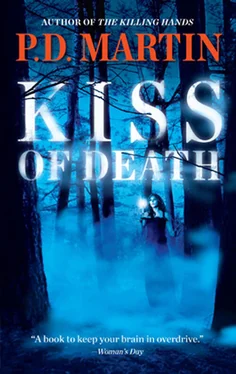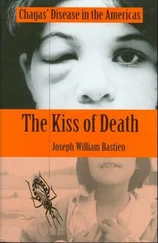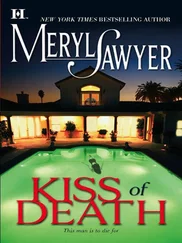“Even though the ranger saw other people running off?”
Sloan nods. “Yup.”
“So they were protecting the group. Either of their own volition or under orders.”
“Yeah.” Sloan’s thoughtful. “A single leader makes it more likely it’s a cult, yes?”
“Not necessarily. While one of the characteristics of new religious movements is an enigmatic leader who has complete control over his followers, most everyday groups have some sort of leadership hierarchy. A school has a principal, a board of directors has a chairman and even a group of hobbyists will have one main person who directs the action.”
Sloan turns to me. “We’re hardly talking schools, corporations or hobbies here, Anderson.”
“I know. The cult angle is a definite possibility.”
Silence for a beat before Sloan says, “Even if After Dark is a cult, it doesn’t mean they’re involved in anything illegal, let alone murder.”
I stop at traffic lights on Sunset. “Point taken. And I have to admit I don’t know much about the vampire subculture, although I know it’s associated with the Goth culture.”
“Me, neither. Nightlife in L.A. is always interesting.” She smiles. “According to the files, Davidson and Riley had been to a Goth nightclub before they were arrested.”
I raise my eyebrows. “Maybe we should check it out…check out their nightclub scene.” I stifle a smile, imagining Sloan and I dressed like we are now and flashing our badges at a Goth club.
Sloan smoothes down the fabric on her pants. “I know we’ve got the so-called fang marks, but I’m more interested in her love life as a starting point.”
Sloan’s going for the most common angle—the boyfriend or husband did it. She’s also not putting much faith in Heeler as an eyewitness, but she could be right about him.
“I agree we need to check out any boyfriends or exes, but I’d still like to know more about this scene. We could talk to the managers or bar staff at these clubs. See what they know about After Dark.” I pause, my mind jumping ahead to the evening. “Maybe even drop by tonight, when they’re setting up…”
Sloan’s nose crinkles. “Maybe. But like I said, I’m more interested in the men in Sherry’s life, not to mention building a timeline of her movements last night. What happened between 9:00 p.m., when she left her family home, and her entrance into Temescal Gateway Park?”
Sloan’s thinking of the case like most cops would—trace the victim’s last known movements. And while we do need to do that, my interest as a profiler focuses more on human behavior, including group dynamics and the lifestyle of a subculture our victim may have been involved in.
“What if Sherry Taylor was a Goth? Could be she was at one of the clubs herself last night.”
Sloan shakes her head. “Not if the family photos I saw this morning are anything to go by.”
“She could have been hiding it from her parents, or maybe it was recent.” I’m starting to feel like I’m flogging a dead horse, but my dream points toward multiple perps, not a boyfriend.
We sit in silence for a bit before I say, “The parents reported her missing this morning, right? Shortly before the ranger found her body?”
“Uh-huh. It was logged at eight this morning. An officer took the report over the phone, and issued an APB for Sherry and her car. But it would have been a few days before the report made its way to the Missing Persons Unit.”
I nod. The procedure for a missing persons case varies depending on the situation. If Sherry had been five years old or if there had been evidence of a struggle in her home, resources would have been thrown at the case immediately. But as a twenty-year-old woman, chances were that she simply stayed over at a friend’s or boyfriend’s house and didn’t tell her parents. Her name would have been in the system; but only if the parents were insistent enough would someone have checked the hospitals and police system this morning to make sure Sherry hadn’t been hospitalized or arrested. And then if Sherry still hadn’t turned up, the case would have been assigned to someone in the LAPD’s Missing Persons Unit within a couple of days. Their next move would have been to interview the parents and close friends, start making inquiries at her workplace and maybe on Wednesday or Thursday they would have started with credit card traces and phone records. Now, with Sherry dead, Sloan will start the ball rolling on all of those things, though, sadly, toward a different end than finding her.
The navigation system prompts me to take a right, and within a few minutes we’re pulling up at the Brentwood home of Mr. and Mrs. Taylor. As we drive up to the gated entrance, the house is visible in the distance. It’s a large two-story home, bagged white with a distinctive Mediterranean feel, wood-stained window- and door-frames and an outside timber shutter on each window.
Sloan presses the buzzer at the gate and after only a few seconds a male voice answers.
“It’s Detective Sloan from LAPD again, sir.”
“Right…come on in.” The voice is distracted; I assume it’s Mr. Taylor’s.
A brick-paved driveway snakes toward the house, past beautifully landscaped gardens. We follow the driveway and park near the front door, opposite a small fountain. The water feature is blue-tiled, with white mosaic-style images of mermaids on the internal walls. Small umbrella palms line a path from the driveway to the front door.
We’re not even up the two steps when a man in his mid to late forties opens the door. He wears thick but trendy framed glasses, a red T-shirt and black jeans. His face is plagued with despair and I know instantly that I’m looking at Sherry’s father.
Sloan clears her throat. “Thanks for seeing me again, Mr. Taylor.”
He nods.
“This is Special Agent Anderson from the FBI.”
He tries to force a polite smile, but it comes out more like a grimace as he shakes our hands. “Come in.”
He leads the way through a foyer section of the house. I’ve changed back into my regular work shoes, and they make a loud clipping sound on the slate, the noise triggering a vision.
Sherry opens the front door, takes off a pair of high heels and tiptoes along the hallway.
The vision is probably an accurate insight of Sherry coming home late one night, or perhaps it was a regular Friday and Saturday night routine for her. Regardless, I doubt it’s of consequence to the case. It certainly doesn’t give me a sense of what might have happened to her last night.
The house is very light and mostly open—a staircase to the right, almost immediately at the entrance, and to the left the space is barely separated into rooms. From here I can see a living room, dining room and expansive kitchen. Mr. Taylor takes us through the first room, which seems like a formal living room or sitting room, through the dining room and into the kitchen. To the right of the kitchen is another living space, which opens up onto a large deck with double doors and a swimming pool. He takes a seat on one of the leather couches and we sit on the couch opposite him.
Sloan props on the edge of the couch. “Is your wife here, Mr. Taylor?”
“Um…yes. She’s upstairs…lying down.”
“It would be better if we could talk to you together.”
He rubs his hands up and down his thighs. “I don’t know if Mandy’s up to it, Detective.”
“Please…it is important. Would you mind asking her if she could come down? Even for a little while.” Sloan’s voice is both sympathetic and authoritative. She realizes it’s much more likely for a mother to know about a young woman’s comings and goings than a father.
Taylor nods in an absent manner and he heads up the stairs.
Читать дальше












